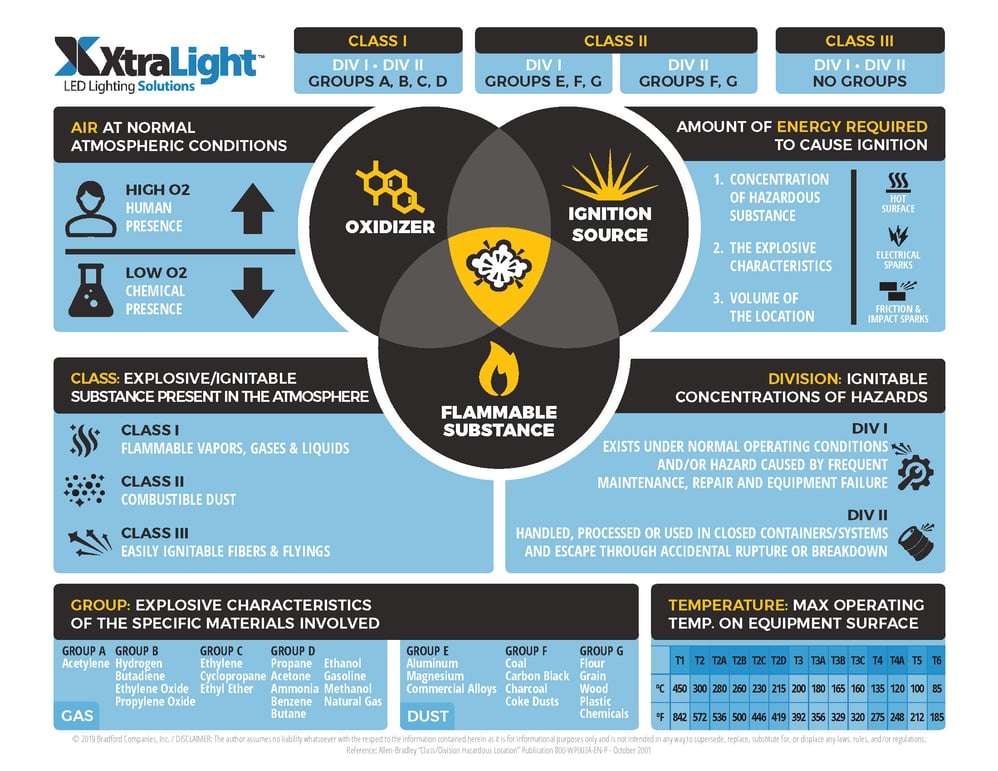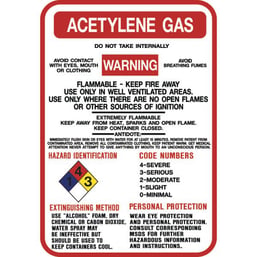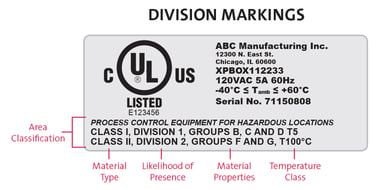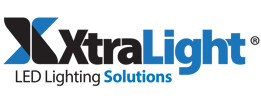
The Class, Division, and Group system based on Article 500 of the National Electric Code (NEC) is defined by The National Fire Protection Association (NFPA).
XtraLight Hazardous Location Products
XtraLight offers a selection of Hazardous Location products that are Class I, DIV2 2 classified To view the full collection: CLICK HERE
Class and Division System
The Class, Division, and Group system based on Article 500 of the National Electric Code (NEC) is defined by The National Fire Protection Association (NFPA). This classification system determines required protection techniques, and methods for electrical installations within hazardous locations.
- Classes I, II, III: Defines the general nature of the hazardous materials within the surrounding atmosphere.
- Divisions I and II: Defines the probability of hazardous materials being present in the surrounding atmosphere.

- Groups A, B, C, D: Defines the type of hazardous materials in the surrounding atmosphere.
A- Acetylene
B- Hydrogen
C- Ethylene
D- Propane
What is Class I Division II?
In reference to possible danger, Class I is defined as a hazardous location in which flammable gas or vapor may be present in sufficient quantities to be considered ignitable or explosive. According to Article 500 of the NEC, one of the following three situations must exist in order to be classified as a Class I Division II location:
1. Volatile flammable liquids or flammable gases are handled, processed or used, but the hazardous liquids, vapors or gases will normally be confined within closed containers or closed systems from which they can escape only in the event of accidental rupture or breakdown of such containers or systems, or as a result of abnormal operation of equipment.

2. Ignitable concentrations of gases or vapors are normally prevented by positive mechanical ventilation, and which might become hazardous through failure or abnormal operations of the ventilating equipment.
3. Adjacent to a Class I, Division 1 location, and to which ignitable concentrations of gases or vapors might occasionally be communicated unless such communication is prevented by adequate positive-pressure ventilation from a source of clean air, and effective safeguards against ventilation failure are provided.
Common locations of hazardous locations may include: refineries, utility gas plants, coal mines, and liquid-gas/gas storage facilities.
UL and C-UL Class I Division II Certifications:
Equipment designed for use in hazardous locations must be tested and certified through a Nationally Recognized Testing Laboratory (NRTL) such as: UL, MET, FM, CSA, or Intertek (ETL). Construction of Class I Division II fixtures are regulated by UL 844 and NEC Article 501 to provide reliance between manufacturers and consumers. Additionally, thorough testing of these products will determine resistance to specific hazardous environments in order to certify individual classes, divisions, groups, and temperatures. For example, lighting fixtures must be designed to contain any and all arching/sparking.
Regulation is critically important in sustaining safe working environments, and with the ever-growing industrial world reliability is paramount now more than ever. When investing in hazardous location equipment, it is also pertinent to understand every requirement for each fixture location. Understanding these fundamentals is just the first step, and for more information regarding hazardous locations and NEC and UL regulations, please visit their websites directly.
_______________________________________________________________________________________________________
Sources:
29 CFR 1910.307 – Hazardous (Classified) Locations
29 CFR 1910.399 – Definitions Applicable to Subpart S
“Acetylene.” National Center for Biotechnology Information. PubChem Compound Database, U.S. National Library of Medicine, pubchem.ncbi.nlm.nih.gov/compound/Acetylene
“Current List of NRTLs.” Occupational Safety and Health Administration, OSHA, www.osha.gov/dts/otpca/nrtl/nrtllist.html.
“Ethylene.” National Center for Biotechnology Information. PubChem Compound Database, U.S. National Library of Medicine, pubchem.ncbi.nlm.nih.gov/compound/6325.
Fire Protection Handbook 20th edition – National Fire Protection Association
“Hydrogen.” National Center for Biotechnology Information. PubChem Compound Database, U.S. National Library of Medicine, pubchem.ncbi.nlm.nih.gov/compound/783.
National Electric Code 2014 edition – National Fire Protection Association
“Propane.” National Center for Biotechnology Information. PubChem Compound Database, U.S. National Library of Medicine, pubchem.ncbi.nlm.nih.gov/compound/6334.
_______________________________________________________________________________________________________
Please Note:
The information contained in this publication is intended for general information purposes only and is based on information available as of the initial date of publication. No representation is made that the information or references are complete or remain current. This publication is not a substitute for review of the current applicable government regulations and standards specific to your location and business activity, and should not be construed as legal advice or opinion. Readers with specific questions should refer to the applicable standards or consult with an attorney.

